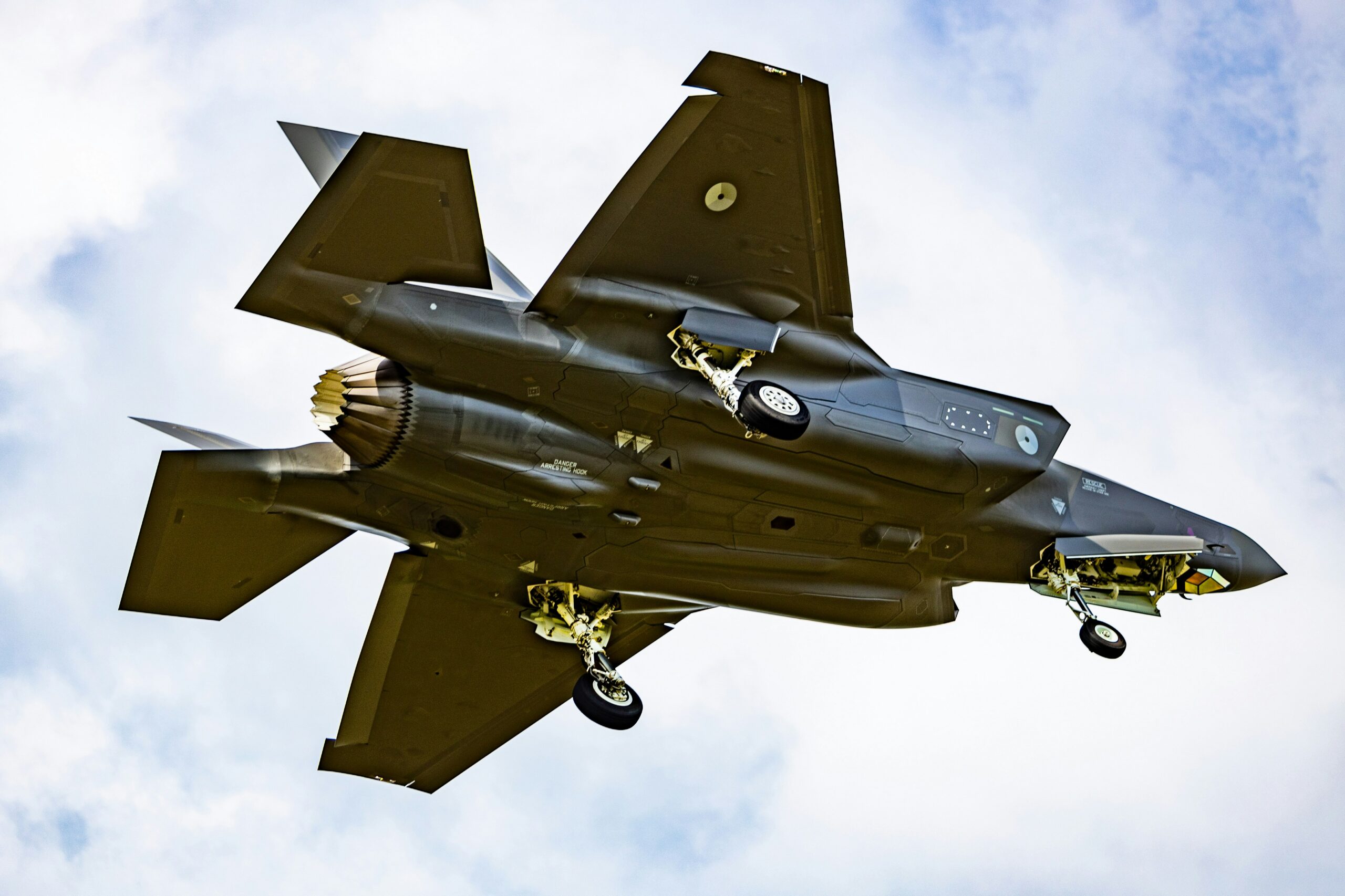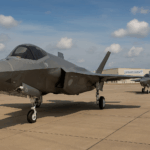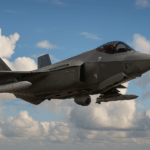The Pentagon just raised the F-35 bill again. Numbers inside its fresh acquisition report point to $438 billion for development plus production. Last year they put the figure at $412 billion. Now planners must live with extra $26 billion – they said inflation and stretched schedules forced the jump.
F-35 Cost Trajectory Since Contract Award
Lockheed Martin won the fighter deal in 2001. Back then officials spoke about $233 billion for the whole effort. Two decades later the jet sits on carrier decks, desert strips, and Arctic ramps, yet the ledger keeps growing. Parallel programs, such as the ISR aircraft contract for Jordan under the FMS framework, also reflect how shifting priorities and geopolitical conditions impact deployment and cost. The latest rise looks small beside earlier spikes, still critics call it another warning sign.
What Changed in 2022 — F-35 Cost Increase
- Inflation re-scoring: Analysts used 2022 money, not prior-year dollars.
- Schedule shift: Air Force, Navy, Marines now plan buys out to 2049, five years longer.
- Engine tweaks on hold: Pratt & Whitney upgrade talks stalled, so baseline support stayed in.
- Block 4 software delays: Extra test flights, more lab hours.
- Spare parts inflation: Titanium, microchips, fast shipping all cost more this cycle.
F-35 Cost to Build
Program accountants track a metric named Program Acquisition Unit Cost (PAUC). It mixes every research dollar with every jet on order. Last year PAUC sat at $166 million. Now it reads $179 million. Raise looks small on paper, yet commanders buy dozens at once, so every-million hurts. For comparison:
| Variant | FY22 PAUC | FY23 PAUC | Change |
| F-35A | $151 M | $162 M | +7% |
| F-35B | $177 M | $191 M | +8% |
| F-35C | $199 M | $214 M | +8% |
Numbers above sit in “then-year” dollars, meaning each row already holds inflation. Some staff hate the table since it shows how far the jet drifted from early flyers that ran near $100 million apiece. A recent GAO cost review also flagged these pricing trends, noting how software delays and retrofit burdens push total acquisition costs higher.
Why F-35 Prices Keep Moving
1. Concurrency Hangover
Early leaders pushed jets off the line while key subsystems still in redesign. Crews now retrofit older airframes. Each tear-down means extra labor, re-rig wires, fresh stealth coating. Shops in Fort Worth call it routine; auditors call it expensive.
2. Software Spiral
The fighter’s brain hosts more than eight million code lines. Every quarter engineers add radar modes, data links, cyber locks. Old functions then break, test teams redo flights, small bugs leak into fleet ops. Clock ticks, cost climbs.
3. Supply Chain Shocks
Titanium out of Russia dried up in 2022 spring. Foundries scrambled, prices doubled for few months. Same season, microchip lead times hit 66 weeks. Suppliers bought from brokers, paid premiums, passed bills upward.
4. Workforce Turnover
Lockheed hired 3 000 mechanics in 18 months, many still green. Rookie error rate sits higher, re-work hours add up. Training lines try to keep pace, though class slots stay tight.
5. Energy Prices
Forging shops burn gas by the tanker-load. Electric arc ovens run nonstop. Summer 2022 bills spiked 40 percent. Contractors hedged late, so hit landed on cost sheets.
F-35 Cost Context
The $26 billion rise equals:
- Roughly what Congress set aside for the Ukraine Security Assistance Initiative during 2022-23.
- Almost NASA’s entire FY-24 request.
- About half the U.S. Army’s yearly procurement account.
Capitol Hill staff read the report last week. Some shrugged, others flagged pages with bright tabs. House authorizers plan to drill the program chief at a May hearing. Senate appropriators already asked the watchdog office for a quick health check.
Fleet Size Stays Fixed—For Now
The document keeps 2 470 total U.S. aircraft (14 test jets, 2 456 production). Services did not cut tails despite talk of shrinking training squadrons. Yet whisper circles suggest the Air Force studies dropping 60 A-models to fund the new NGAD fighter. Marines weigh more CH-53K buys, which could nip some B-model orders. Navy leadership silent so far.
Sustainment Shadow
Upfront dollars grab headlines; support dollars loom larger. Current life-cycle cost forecast, last public in 2020, hovered near $1.3 trillion through 2088. New figure arrives this summer. Insiders expect jump: fuel price path up, depot backlog growing, and engine overhaul rates climbing faster than predicted.
Field units report mission-capable rates stuck near 55 percent. Parts shortages, software faults, canopy sealer cracks—all drag readiness. Pentagon aims for 70 percent but hides monthly charts after sharp press questions. Maintainers swap gear at night while pilots fly the few jets cleared by dawn.
International Partners Feel Pinch
Nine original partner nations watch U.S. numbers because their share formulas ride the same curves. Norway’s Parliament now faces an extra NOK 3 billion bill over next decade. Italy’s Court of Auditors asked defense ministry why new simulators doubled in price. Australia paused talk of a second squadron; treasury wants updated sustainment tables first.
Foreign Military Sales buyers—Finland, Switzerland, Germany—signed deals pegged to 2021 rates. Each has inflation clauses yet still pickup surprise fees: spares pools, tech data patches, software re-hosting kits. Helsinki already told Lockheed its first payment came €110 million over budget. Company offered slower delivery or extra financing line.
Engine Debate Still Open
Pratt & Whitney F135 meets basic spec yet runs hotter with Block 4 loads. Air Force Research Lab pushed the Adaptive Engine Transition Program (AETP). Congress cut AETP funds in FY-24 markup. Some lawmakers said fleet cannot afford two engine lines. Pratt pitched a “core upgrade” cheaper path. Decision now falls in autumn budget cycle. Any choice will reshape cost curves again. One Pentagon estimate places the engine-related repair burden at a $38 billion engine fix across the aircraft’s lifetime.
Industrial Footprint
Main line at Fort Worth churns near 147 airframes per year. Extra fuselage sections come from Italy and Japan; wings from Turkey no longer flow after 2019 ban, so new vendor in Arizona still ramps up. Paint bay squeeze slows final wrap. Workers clock overtime; union warns burnout but signed contract with 3.5 percent raise only.
Downstream, Honeywell, BAE, Northrop, Collins all feed sensors, landing gear, avionics. Each faces own cost pressures: labor, cyber insurance, quality escapes. A cracked anti-ice valve halted deliveries for nine weeks last winter. Fix cost small yet headlines screamed delay again. The engine unit cost continues to rise, adding new pressure on sustainment budgets across partner nations.
Comparative Programs
| Program | Current Dev+Procure Cost | Airframes | Notes |
| B-21 Raider | $203 B | 100 | stealth bomber in flight test |
| Columbia SSBN | $128 B | 12 | nuclear submarine class |
| KC-46 Tanker | $55 B | 179 | still clearing remote-vision faults |
Even combined, these three sit under the F-35 outlay. Critics say single fighter should not outspend bomber plus submarine. Pentagon counters that F-35 replaces four legacy jets across three services.
Export Leverage
Despite cost angst, foreign interest stays high. Reasons:
- Access to U.S. weapons integration pipeline.
- Shared upgrade road-map reduces per-country software bill.
- Combined training lowers simulator costs.
- Political weight: owning F-35 signals tight bond with Washington.
Israel already fields bespoke F-35I Adir variant. Japan funds indigenous datalink tweaks. U.K. saved money by dropping its CATOBAR carrier dream, went pure short-takeoff. Each choice walks cost-risk line.
Congressional Outlook
House Armed Services Committee chair said last week, “We will hold feet to fire on affordability.” Ranking member shot back that cancelling buys now wastes sunk funds. Budget notes show split:
- Some propose slowing FY-26 order by 20 jets, use savings for hypersonic defense.
- Others push multiyear block buy to lock lower unit price.
- A third camp wants sustainment contract overhaul first.
Votes land during markup in June. Lobbyists already book hotel rooms near Capitol South.
Past Promises vs. Present Reality
2001 brochure lines claimed:
- “Common airframe yields scale savings.”
- “Digital thread cuts rework.”
- “Open system simplifies future mods.”
Reality shows partial hit: airframe commonality sits around 25 percent by cost, digital thread still under patch, open system blocked by intellectual property fights. Supporters answer that Cold War fighters blew budgets too yet still served forty years.
Possible Off-Ramps
Pentagon owns few levers:
- Reduce fleet objective—risk joint force gaps.
- Cut specs—drop some Block 4 apps, accept lower sensor fusion.
- Re-compete sustainment—invite third-party MRO houses, shake prices.
- Boost multiyear deals—swap volume for unit discount.
- Push allies to shoulder R&D—sell early stake in Block 5.
Looking Ahead
Next Selected Acquisition Report arrives March 2026. Between now an then program office must:
- Certify Block 4 tactical-nuclear mode.
- Finish TR-3 hardware install across line.
- Set long-term engine plan.
- Lift mission-capable rate above 65 percent.
- Close open quality escape tickets below 30 per quarter.
Meeting even three goals would please oversight teams. Missing more could trigger another Nunn-McCurdy breach, though insiders bet Pentagon will juggle numbers to stay under. Analysts have also outlined various future scenarios for the F-35 program amid mounting costs and shifting priorities.
Bottom Line
F-35 remains core to U.S. air power, yet its price arc keeps bending upward. Fresh $26 billion bump may look small against the giant base but signals pressure that never quite ease. Until software locks, supply chain calms, and sustainment plan stabilizes, budget drafters will brace for more nudges. Fleet crews will still strap in, punch burners, an rely on the jet the nation already bought.
REFERENCE SOURCES:
- https://apnews.com/article/trump-f35-defense-military-fighter-jets-7e18c5459228d16769385dd0b8c3d930
- https://caliber.az/en/post/pentagon-announces-significant-price-increase-for-f-35-jet-program
- https://www.esd.whs.mil/Portals/54/Documents/FOID/Reading%20Room/Selected_Acquisition_Reports/FY_2023_SARS/F-35%20MSAR%20Dec%202023.pdf
- https://www.gao.gov/products/gao-24-106703
- https://www.dvidshub.net/news/494810/clarification-f-35-program-cost-estimate-providing-facts-behind-2t-number
- https://www.reuters.com/world/us/pentagon-withholds-5-mln-per-f-35-jet-deliveries-resume-2024-08-29/
- https://www.wired.com/2012/03/f35-budget-disaster/
- https://www.gao.gov/blog/f-35-will-now-exceed-2-trillion-military-plans-fly-it-less
- https://www.airandspaceforces.com/what-might-the-future-hold-for-the-f-35/
- https://armscontrolcenter.org/f-35-joint-strike-fighter-costs-challenges/



